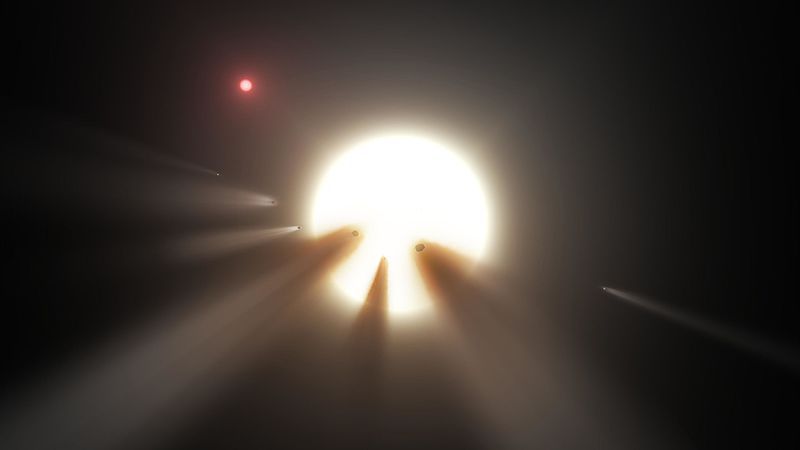
Since its discovery two years ago, a star that resides around 1,300 light years from Earth has gained a reputation as the most bizarre in the galaxy. Named KIC 8462852, the star gained worldwide attention when scientists suggested its weird behaviour could be explained by the presence of a huge shield built by an advanced alien civilization.
Back then Tabetha Boyajian, from Louisiana State University, and her colleagues discovered that KIC 8462852 exhibited huge dips in its brightness at regular intervals using data from the Kepler Space Telescope—sometimes by as much as 20 percent.
The brightness of a star normally dips when an object, such as a planet, passes in front of it. But even a gas giant like Jupiter—the biggest planet in our solar system—would only block around two percent of the light from our sun. A planet would also only cause light at certain times because of its orbit, which means whatever is causing the dimming at KIC 8462852 must be absolutely massive—and cannot be travelling along a normal orbit.
Since its discovery, the star has been monitored constantly and numerous papers have been published proposing theories about what could be causing the dips. As of yet, however, none have been able to adequately explain what is going on.
At the end of August, two new papers were published looking at the dimming from KIC 8462852, both looking at the long term change using different telescopes—one with the Spitzer Space Telescope, the other with data from the All Sky Automated Survey (ASAS).
In the ASAS paper, researchers found that between 2015 and now the brightness of KIC 8462852 has decreased by around 1.5 percent. But they also found that over the past 11 years, the star has experienced two "brightening episodes." "This long-term variability is difficult to explain with any of the physical models for the star's behavior proposed to date," the team concludes.
Boyajian tells Newsweek the paper she worked on also looked at the long term dimming, rather than the short term variability, where dips in its brightness are seen from days to weeks. "What we found was that this star has been shown to have this fading and we've been able to measure the fading in each wavelength," she says. By measuring the dimming in different wavelengths, scientists can get a completely new view on it—potentially providing a different insight into the cause.
"It brings more evidence to the table, that this star has this long term variability—that it has been dimming over the last year and a half," she says, adding that while the research does not necessarily rule any of the proposed theories out, it does indicate larger particles are blocking the light.
So what is going on with the star? In May, scientists monitoring KIC 8462852 were able to record a dip in the brightness in real time, utilizing scientists across the globe to record the star's behaviour as it happened. The mountain of data from this event is currently being analyzed. "We are trying to go through it all and put it together into one cohesive results," Boyajian says. "It is a lot of data and we want to make it impactful in the timeframe we're working on."
At the moment, the evidence does not point to a single scenario. Every proposal would have to be on the most extreme scale of what we believe possible for it to work. And it could be a long time before we have the answer.
"This long term variability seems to have variations over several years, if not decades. That's kind of the timeframe we're looking at. There are a lot of people working on it. [The answer] will come, we just don't know when," Boyajian says.
"Another important thing we need to do to try to understand this star is to find others like it, because you have better chance of figuring it out if you have a sample bigger than one."
Having another star exhibiting similar behaviour would help scientists understand what is happening around it. "We just don't have that data yet. The Kepler telescope has looked at less than a tenth of one percent of our entire sky. There could be thousands of similar stars out there or there could be none of them. We don't have any way to constrain it so far."
Boyajian says that her favorite theory of what is causing the dips so far is "some sort of circumstellar material," potentially a swarm of comets falling into the star. "That could still fit in the constraints, but we have the problem of the amount of material you would have to have and the special orbits this material would have to be on is extraordinary […] but not completely impossible," she says.
"Every theory that's been proposed is [far more extreme] than what we know to exist now. So we're looking for a solution that works with a reasonable physical mechanism we can postulate. But who knows nature is a lot more creative than we are, and that's what I keep telling myself. We just need to keep thinking about this and what's causing it."
Uncommon Knowledge
Newsweek is committed to challenging conventional wisdom and finding connections in the search for common ground.
Newsweek is committed to challenging conventional wisdom and finding connections in the search for common ground.
About the writer
Hannah Osborne is Nesweek's Science Editor, based in London, UK. Hannah joined Newsweek in 2017 from IBTimes UK. She is ... Read more
To read how Newsweek uses AI as a newsroom tool, Click here.








